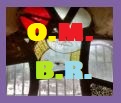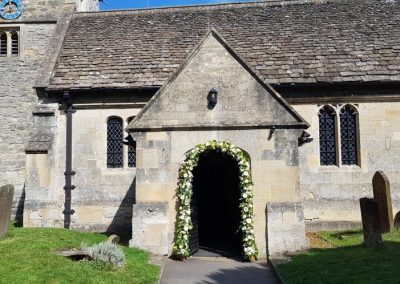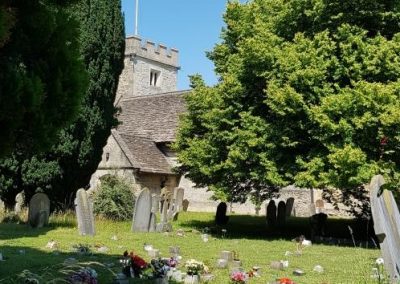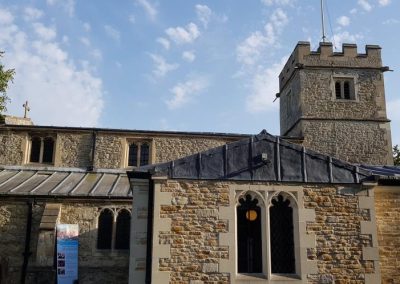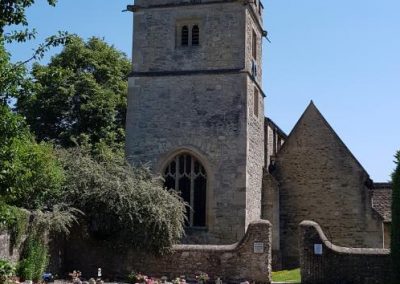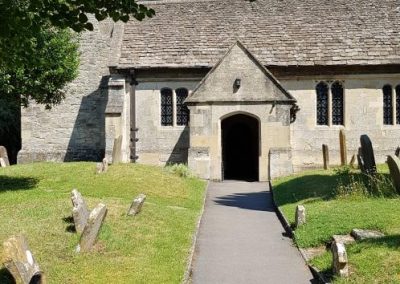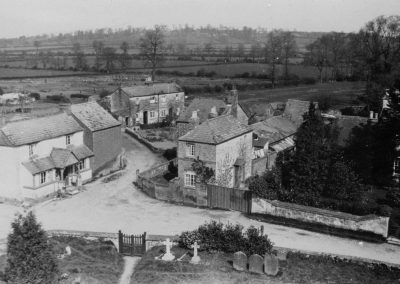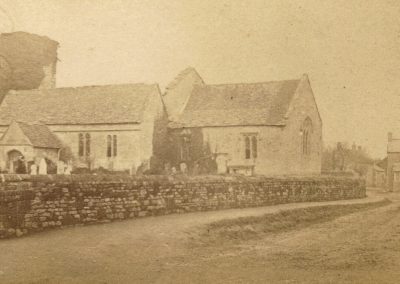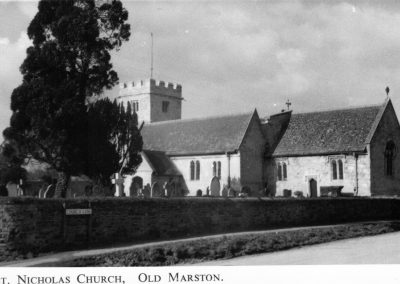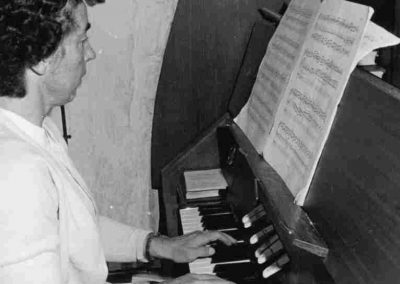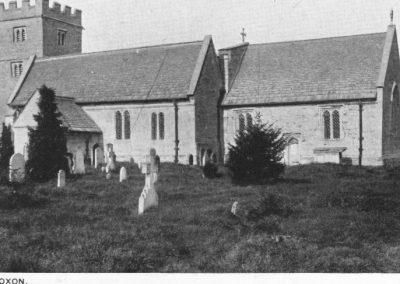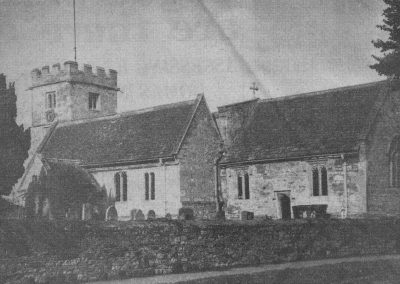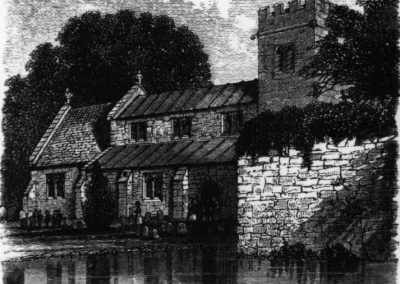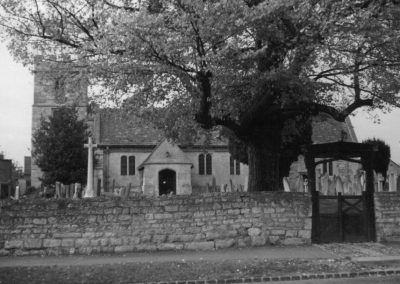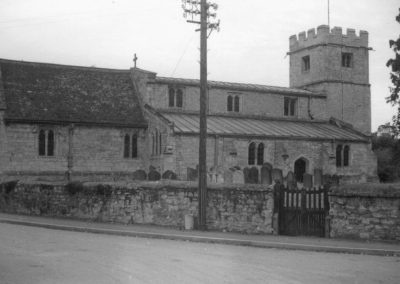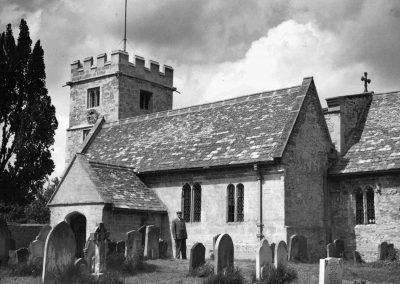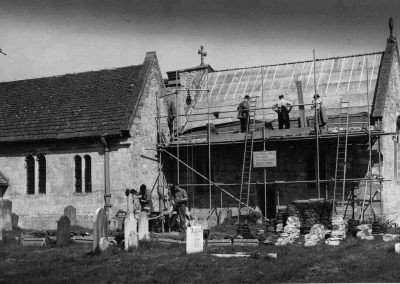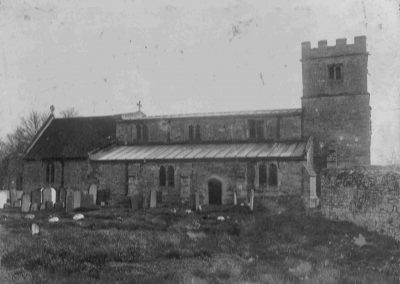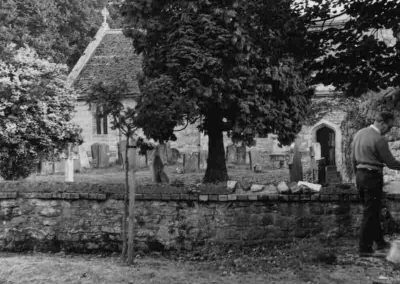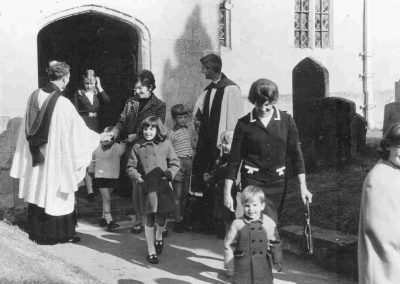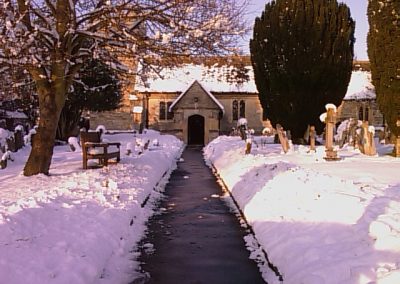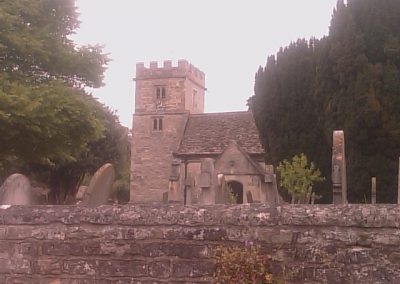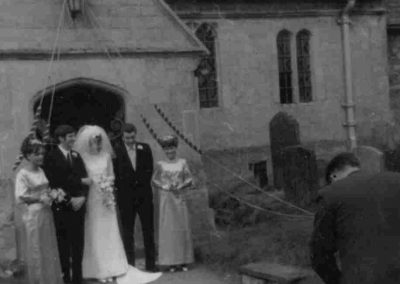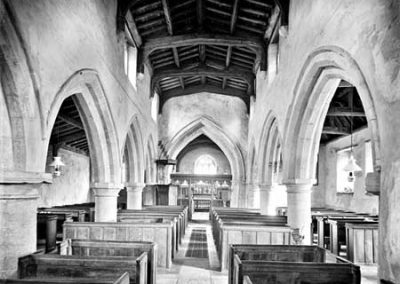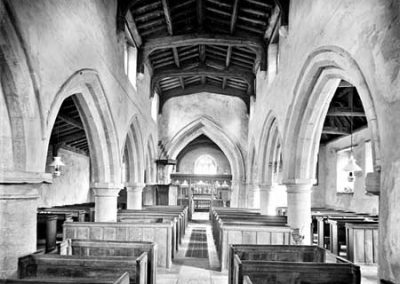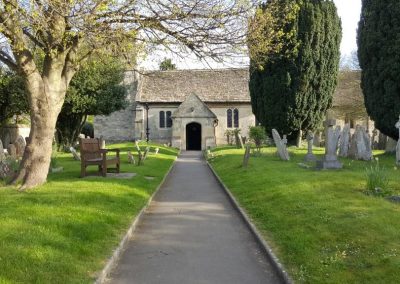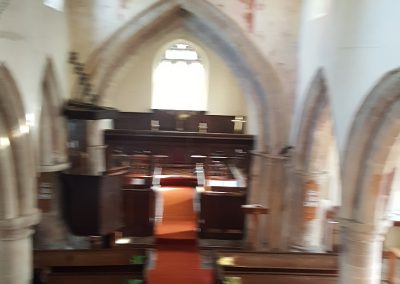St Nicholas Parish Church
The first reference to the ‘Chapel in Marston’ is in 1122 when it is assigned to the Augustinian Canons of St. Frideswide. We can still see today part of the building work of the latter end of the C12th in the chancel arch, the arcade of the nave and the inner south door. This work was done when the church was endowed with land by the lord of the Manor of Headington. Further changes and additions continued in the 15th and 16th centuries. Very recently the vestry (built in 1977) has been enlarged.
By the right hand side of the vestry door visitors can find a list of the clergy responsible for the church from 1210, beginning with Osbert, son of Hereward, to the present day, with just a gap between 1529 and 1637. The 16th century was a time of upheaval and religious change, but there is little evidence of how people reacted in Marston. The article on the Civil War records our knowledge of the effect on the church of the crisis of the English Civil War.
During the 18th and early part on the19th century Marston had no resident vicar, but was served by various clerics from the university. In 1849, Canon Richard Gordon was appointed vicar here. He had been vicar of Elsfield since 1832, and continued to live there, whilst a curate took most of the services in Marston. The first incumbent to live in a vicarage here was the Revd John Mortimer, who came in 1904 to a house built for a comparatively wealthy Marston family, and stayed for 46 years. He was a keen musician and trained the school choir as well as that in the church. His life here is marked by Mortimer Road and Mortimer Hall. A purpose built vicarage came later when Paul Rimmer was vicar.
Today, the church is at the heart of the village as it has been for almost 900 years. The interior and the graveyard are lovingly cared for by a willing team of volunteers, while the very active congregation play their full part in the community.
Website: https://stnicholasmarston.org.uk/
Taken from the history of St. Nicholas Church by Tony Kelly.
Printed in Marston Times January 2008
Reprinted by permission Jan Sanders Editor
A Guide to the Architectural Antiquities in the Neighbourhood of Oxford 1846
Marston Church = see ‘A Guide to the Architectural Antiquities in the Neighbourhood of Oxford’, Oxford Society for Promoting the Study of Gothic Architecture. Parker, Oxford 1846 [City Ref L]
pp 185-188 ill.: ground plan; Sculpture over E. Window; dripstone termination; chancel door; arch south of Nave.
Last Sentence:
CROSSES: In the church-yard there wes formerly a cross, which was taken down to mend the wall with in the yeat 1830; and in the village another cross, which was used about the same period to mend the roads with!
p188 (re Crokes house) This house was pulled down in 1843
Early 20th Century Observations by Unknown Author
Area of Parish, 1160 acres. Population, 668.
The CHURCH. Dedication—S. nicholas. The Nave arcades and Chancel arch date from the I3th century and a transition Norman.
The Church was rebuilt in the Perpendicular style in the I5th century. It was thoroughly restored in 1882-3 • the work being carried out by Mr. John Honour, of Marston, under the superintendance of Mr. H. Drinkwater, the architect, and was re-opened for Divine Service after the restoration, on Thursday, December 6th, 1883, by the Bishop of Oxford. The then Vicar was the Rev. J. P. Smith.
A new open timber oak roof was built to the Chancel, the principals having carved braces as nearly as possible on the lines of the old roof and the spandrils being filled with tracery.
The roofs of the nave and aisles were stripped and renewed where necessary : the interior cleaned of many coats of whitewash arid the plastering repaired : while the exterior was re-leaded and slated. Some remains of texts with borders of the time of Elizabeth or James I. were discovered, and an aumbrey at the east end of the north aisle.
The old seats were thoroughly restored, and in the chancel the old return stall desks have been retained with new stalls and a screen across the chancel arch.
The Jacobean pulpit was repaired, a new base was added to it and the canopy supported by a piece of wrought iron.
The East window was put in in the year 1903 by Miss Rippington, to the memory of Mrs. M. A. Cannon and other relatives. It was designed by Mr. F. C. Eden, of 3 Staple Inn, Holborn. The centre light has the Crucifixion for its subject ; the right-hand light, St. Nicholas, the patron saint of the Church ; and the left-hand light, St. John the Baptist. Some fragments of old glass have been skilfully inserted.
The side windows are of two lights, late Perpendicular. There are some good quarrels of painted glass in the heads of these windows. The recess of the first window on the south side is carried down to a stone bench which served as a seat for the priest, and eastward of this is a small square piscina with the basin and drain perfect.
There is a ” hagioscope ” or ” squint”‘ in the south aisle, enabling worshippers to see the Holy Table. The font is modern imitation Gothic. The Church possesses a chalice of early I4th century workmanship.
The manor house shown in the engraving was the seat of Unton Croke, Esq., a supporter of the Parliament in the Civil War, Who acquired it by his marriage with Anne, daughter and heiress of Richard Hore, Esq., of Marston. Here Oliver Cromwell received the surrender of Oxford in May, 1646. The right half has been rebuilt and forms a separate dwelling.
The cross was taken down and used to mend the roads. A similar Cross stood jn the Churchyard and was taken down in 1830 to mend the wall.
The living is in the gift of Mrs. Evans of Eton, widow of the late Master of Pembroke College, Oxford
Description taken from 1932 Motoring Guide
The church of St Nicholas has quire, clerestoried nave, aisles, S. porch and a low embattle SW tower of perp. period. The porch has been rebuilt but retains the old stone seats, also the EE inner doorway. Note the archaic sculptured finials to the label, and a votive cross on the jamb. The quire has a mutilated piscina on the S. and the window sill is lowered for sedilia. The three-light E. window is Perp., as also the four of two lights N. and S., and the priest’s door.
Note the old balustrade altar rails and two good sanctuary chairs. There are fragments of ancient glass in the windows. The imposts of the chancel arch indicate an original Norm. arch as they are of that period, but the present arch and jamb-shafts are E.E.
The nave arcades are late E.E., cylindrical pillars and rude octagonal moulded caps., but on the N. the bases appears to be earlier (Norm.). The clerestories are perp. The N. aisle has an aumbry. The E. window of three lights is early Perp. and has remains of old stained glass. The other window of nave isof three lights, perp. The S. aisle has a hagioscope, one two-light perp. There are traces of mural paintings on the pillars, arches, over S. door, and on E. wall of quire. Note the good Jacobean pulpit. The exterior of the priests’ door on S., and the two windows should be noticed. The finials to the hood-moulds have a rebus on them.
[Bird, W. Hobart. Old Oxfordshire Churches. A concise guide, especially compiled for motoring folk and others… London. Ed. J. Burrow & Co. Ltd. [n.d.]. Foreward dated February 1932]
Vicars of Marston
c. 1210 Osbert son of Hereward (Heward)
Pre-1263 Walter
1263 Richard
1264 Kytellus (Ketellus)
1273 William de Mercham
Pre-1297 Adam de Wolford
1297 Stephen de Lynermene (Chaplain)
1304 Henry Brid (de Langgebergh)
1320 Roger de Undele
1324 Richard de Grafton
1330 Henry de Keten (Kettone)
1349 John de Bradeley (d. Black Death)
1349 Hugh de Wappenham
1361 William de Hedyngdon
1361 Hugo
pre 1382 Richard de Morton
1397 Robert Kene (Kent)
1398 Adam Wyllyam
1407 Hugh de la Ryner
1407 Thomas Thornbury (Canon of St Frideswide’s)
1423 Theobald Wynchester (Canon of St Frideswide’s)
1424 John Henton
pre 1460 Lewis …
1460 Master William Dayfoot
1483 Master Richard Chauncellor
1484 Master Thomas Gilbert
1486 John London (Canon of St Frideswide’s)
1529 Thomas Fylldar (Dominican)
1637 John Allen
1685 Francis Shaw
1686 Robert Holloway
1689 John Duke
1690 William Smith
1705 Robert Railton (Raylton)
1717 Joseph Stockwell
1728 CarewReynell
1734 William Thomas
1738 Thomas Berdmore
1742 William Burrough
1752 William Wright
1758 John Coxe
1771 Henry Macock
1804 Thomas Harward
1805 Thomas Henry Whorwood
1835 James Peterson Chambers
1836 Thomas Henry Whorwood
1849 Richard Gordon
1872 John Philip Smith
1888 Charles Morris
1899 Harvey Altham Cumberlege
1904 John Hamilton Mortimer
1952 Gordon David Savage
1957 Leslie Vandernoll Wright
1959 Paul Nathanael Rimmer
1991 Anthony Ronald Price
2017 Skye Denno
Carol Services by Candlelight Began in Old Marston – Oxford Mail Article 1966
Candlelight Caroling began at Old Marston (Oxford Mail 19th December 1966)
by Anthony Wood
In common with worshippers up and down with the country, the congregation of St Nicholas Church, Old Marston, joined last night in the Advent Festival of the Nine Lessons and Carols.
But as they sang the traditional Christmas music and listened to the familiar scriptures by the golden glow of candles, I wonder how many of them realised that it was in their lovely 12th century church the first candlelight carol service was held 38 years ago (1928).
The idea was that of Rev. Howard Rose, who was Chaplain to the Oxford Pastorate at the time. In 1927 on Christmas Eve in New York, while visiting friends he had made during the First World War, he happened to attend a service at Calvary Episcopal Church.
“The Rector, the Rev. Samuel Shoemaker,” he told me last night over the telephone from Lingfield – where he now lives in retirement – “has adopted the custom of bearing a big Yule candle into church in procession on Christmas Eve and presenting it to the person who has done the most for the parish during the year.
“But it struck me as I watched on this occasion how symbolic it was of the birth of Christ – the Coming of the Light of the World – so when I got back to England I mentioned it to the vicar of Old Marston, the Rev John Mortimer, whom I used to help during the vacation, and on Christmas Eve, 1928, we held the very first candlelight carol service in St Nicholas Church.”
The form it took has been refined over the years but basically it is the same today as it was then. A chorister bears the Yule candle into the darkened church, then from its flame the clergy and sidesmen with tapers light other candles until nave and chancel glow with golden light.
When he became Vicar of Christ Church, Penge, Mr Rose introduced it there, then at Stansted, then at Windermere, then at Ditchling. And in that way the service spread by word of mouth and imitation until today it is held in churches all over the world.
South India
The Rev. Paul Rimmer, first came across it in 1952 at Windermere when he became Mr. Rose’s curate and subsequently introduced it to South India when he went to serve the Church there in 1955.
But he didn’t have to reintroduce it to Old Marston when he became Vicar in 1959. He says: “After all those years I found it was still being held every year. The symbolism, I’m afraid had been lost. They just put candles round the wall and held the service in a lighted church.
“Nonetheless, it hadn’t died out and it was a simple matter to restore the Christmas message, to demonstrate by the lighting of the candles how Christ brought the light of the Gospel into the world.”
The service isn’t quite as impressive as the one Mr. Rose finally evolved at Ditchling, his last living.
There a star remained alight over the crib in the darkened church. Kissing boughs decorated with mistletoe and rosy red apples – a traditional part of the Christmas scene long before Prince Albert introduced the Christmas tree in 1841 – supported the candles.
“The’re terribly fiddly and take an awful long time to make,” says Mr. Rimmer apologetically. And as the worshippers left after the service they looked out over a wall across a field to a farmyard where was enacted a living tableau of the Nativity Scene.
Bu such shortcomings didn’t bother Mr. Rose when I rang him last night. He was delighted to hear I had enjoyed the service and only sorry he had not been able to arrange something similar in one of the churches around Lingfield.
“Unfortunately, I left it too late,” he said. “But I shall certainly do something next year. And in 1968 – God willing – I am looking forward to celebrating the 40th anniversary of candlelight service with my ……(missing paragraph).
Contact Us
Hugh Deam
(Captain of Bell Ringers)
St Nicholas Church
Marston,
Tel: 07484 223014
Email: hugh.deam@btinternet.com
Roy Peach (secretary)
Tel: 07788746157
email: rpeach87@gmail.com
About Us
We are a group of local people who share a passion for campology - the art of bell ringing. We are part of a tradition that goes back hundreds of years and are always keen to welcome new members who are interested in taking part.
Hand Bells
In addition to the church bells, we also regularly meet to ring hand bells. Contact us to find out more.
